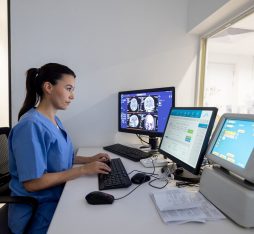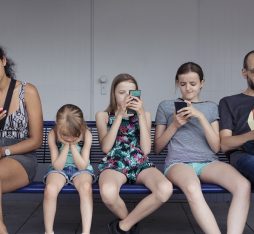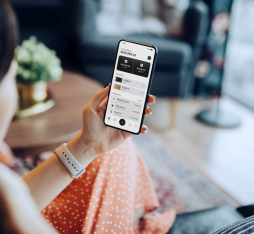Professional training keeps on evolving, with the arrival of digital tools (tutorials, podcasts, webinars, online courses, – SPOCs, COOCs, etc.) [1]. The latest use virtual reality and augmented reality. This move to digitise training was accentuated by the Covid-19 crisis.
To better understand the place of these technologies in training, we conducted a usage study on a training course that used VR, set up at Orange in September 2019 to enable employees to practice public speaking using the storytelling method. We monitored a group of trainees following the course at one particular point in time, the lockdown in the first half of 2020. The article draws on six semi-directive telephone interviews with learners from this group after the training, as well as an interview with the trainer. For the duration of lockdown and the months that followed, the course was transformed into a 100% digital proposition. Observations were also conducted online during the sessions that used VR. Almost all the learners in the group (6/8) agreed to receive headsets at their homes to practice with an immersive brick (VR digital content) made available to them. This study constituted the beginning of a study cycle on the learners taking this course, who would later use enhanced versions of the immersive brick (IB) following the interviews conducted and the avenues for the improvement that emerged from said interviews.
A training that has undergone several transformations
Originally, the training course “Pitching your project through storytelling” was an in-person course, designed to teach learners how to put together a pitch based on their working needs. First, an IB was introduced without changing the in-person structure of the course. The aim of this IB was to raise learners’ awareness of the non-verbal communication (looks, gestures, breathing, smiles, etc.) that accompanies their pitches and their speech in general. The Covid crisis then led the training to go 100% online (seven webinars, including an introductory session), with a greater place for VR. A session specifically devoted to discussing the uses of VR was then introduced. After each session, learners were asked to complete an assignment (individually and/or in groups) that would serve as a basis for the trainer at the next session. Each session enabled learners to acquire the skills they needed to build a convincing speech. The training materials were varied (videos, written documents, diagrams).
The IB is split into two distinct parts. First, for ten minutes or so, the learner is introduced to the main rules of public speaking. They are asked to identify the errors committed by a virtual colleague in a simulated pitch. Second, after this familiarisation with the principles of public speaking, the learner is immersed in a meeting room, where seven virtual colleagues are sitting around a table. This is the point where the learner practices a two-minute pitch, which they can record, listen to multiple times, and start again if necessary.
The IB offers learners two possibilities: they can either work on a pitch pre-designed by the training designer – in which case they can read from a prompter during their pitch – or give their own two-minute pitch related to their work, with no notes to read from.
The IB thus enables them to practice the body-language part of their pitch, as well as the content.
In addition to these individual practice exercises, the session devoted to discussing uses of VR enabled learners to talk with each other and with the trainer about the construction of their pitches and the indicators measured by the VR capsule, using recordings of their practice sessions for reference.
Before talking in greater detail about feedback from users, it is important to highlight the particular characteristics of VR.
The RV, a unique learning tool
According to some researchers, VR’s technical characteristics make it different from other training methods [2].
The main characteristic of VR is immersion, which enables the learner to be plunged into a virtual environment (VE), which may or may not be a faithful reproduction of a real environment (RE). Successful immersion transfers the learner’s attention from the RE to the VE. This is the sensation learners always talk about when they take off their headsets.
The second characteristic of VR is that it enables the individual to move and interact fluidly in this environment. There is interaction that enables individuals to adopt an active learning stance in the VE.
VR also comes with a series of sensors and indicators that give learners feedback at the end of their training: total duration of the training, completion rate, frequency of use, scores achieved on the various exercises and multiple-choice quizzes, as well as the direction of their gaze, the intensity of their voice, etc.
The final particularity of VR is the availability of content, which depends on the number of headsets available to follow given content, as well as the accessibility of content designed within the company or purchased from an external designer (in the latter case, licence duration may also influence the availability of content). Once the organisation has purchased or designed the training IB, it can be repeated as many times as necessary.
Characteristics of VR according to users
Let us now look more closely at the feedback given by the interviewed users about their use of VR.
By immersion: more proximity, emotions, confidence and concentration
The immersion they felt seemed to make practicing easier, by making them feel in close proximity to the virtual colleagues present in the meeting room, as these learners explain:
“Yes, I can see the difference compared to the times when I have prepared for presentations on my own. When I do that, I mumble. What virtual reality offers is the feeling that you have people in front of you…” [Elora]
“When you use the headset to practice, it “grabs” you [Mariana, Director of Training].
We should note that this feeling of proximity is not always immediate, and some take time to immerse themselves in the VE and adjust to the roles expected:
“ …It took me a few goes, but in the end, I started to apply the advice on intonation” [Elora].
This immersion also allows learners to feel particular emotions, particularly a degree of stage fright that they would not have when practicing alone: “With the headset, you feel the stress; you’re simulating the real situation.” [Mariana].
Learners say using VR has a positive effect on self-confidence. First, doing the training at home, in a familiar, safe environment, seems to have a positive effect on the pitcher’s confidence. And this growing self-confidence seems to come from the possibility of rehearsing the pitch several times in the VE until they feel more comfortable. “I did it 2 or 3 times off the cuff this morning, just before my presentation, and it’s great; it gives you self-confidence.” [Elora].
Being cut off from the RE is another reason why the system proves effective. Immersion increases learners’ concentration, by isolating them from external stimuli, such as the interruptions caused by incoming emails or instant messages:
“You are much more involved in it. You really experience the interaction to the full.” [Charline, product manager].
“You’re cut off from your environment; you’re in a bubble” [Mariana].
From this point of view, immersion consolidates one of the pillars of learning: the ability to hold a person’s attention. The learner’s attention is entirely focused on the content of the training.
However, the isolation generated by the VR headset may be experienced as vulnerability, insofar as learners cannot see what is happening in the RE. One other potential issue worth mentioning is that continual exposure to a VE can create physiological problems (headaches, dizziness), also known as “VR sickness”. The time taken for such symptoms to appear varies from one learner to the next.
Limited interactions and feedbacks and more customised content required
When they start using the IB, learners imagine they will get feedback from the virtual participants on their pitches, but in time, they realise that all the reactions of these virtual participants (the audience for their pitch in the IB) are pre-programmed. It doesn’t matter how they deliver their pitch; the reactions provoked are identical.
“ I thought the audience seemed real, and being locked in with the headset, I really felt I was there in the room… But the feedback from the audience is always the same, which gets annoying after a while” [Yoann, business support manager]
“The same person always picks up their phone at the same moment to look at their emails, which makes you feel like they’re bored. There isn’t really the kind of interaction you would need to give you feedback at some point.” [Mariana]
Just as there is no feedback during the delivery of the pitch, it is also missing at the end of each practice session, as the indicators recorded by the system on the quality of the practice (repetition, speaking speed, direction of gaze, etc.) can only be extracted by the trainer after the learner has finished with the IB. These indicators are only used in the session specially devoted to feedback on VR use.
Though the individual practice sessions lack interaction and feedback, the simple fact that learners can repeat their practice as many times as necessary enables them to consolidate good habits (eye contact, smile, gestures, speaking speed, etc.), which is an important part of the learning process.
From this point of view, having access to a VR headset equipped with content to practice repeatedly or undertake different training exercises based on the needs of the learner’s work activities is essential.
As regards the last characteristic of VR, the availability of content, the learners in the studied case had access to the VR headset at home throughout the loan period. The headset needs an internet connection (to calculate the indicators). However, another aspect of the availability of content is the need many learners felt to customise the written support they used for their pitch, by having access to their slides within the VE while practicing. This customisation, as well as the possibility of varying the length of the pitch, enables them to practice in a way that is closely tailored to the needs of their work.
A double necessity: an enabling design…
One of the benefits of this study is that it has contributed to improve and enhance the IB. Learners suggested, for instance, that to make up for the lack of interaction with the virtual participants, it would be useful for them to diversify the scenarios, varying the immersion experiences and thus potentially provoking different emotional reactions from learners. Therefore, two new scenarios have been added on top of the existing meeting room scenario: a one-on-one with a manager in a lift, during which a key message has to be transmitted in two minutes (a so-called “elevator pitch”) and a presentation in front of a large audience in an auditorium.
The designers are also seeking to introduce elements of artificial intelligence (AI) into the IB, which would enable reactions to be generated in real time, based on precise criteria (such as speaking speed).
As regards feedback through indicators, the designers are working on giving learners the possibility of receiving information immediately after their practices (such as their speaking speed compared to an average, or a word cloud to make them aware of any repetitions). These changes to the IB are a step towards enabling design, understood as a stimulating design (immersion, sensation of being present), safe (a space without judgement, where a climate of confidence reigns), and which does not hinder learning (variety of situations in the VE, with possibilities for interaction). It becomes then a strategic tool that makes it possible to update or invent stimulating and motivating learning spaces (by the opportunities that VR, with its scripted and gamified contents in the bricks, brings for the training experience, for learners and trainers alike [3].
But enabling design does not solely concern the IB. It is also about the training path of which the IB is part (for example, the way of connecting the collective discussion phases with the practice done using the IB).
An enabling design therefore encompasses the conception and organisation of both technical and educational aspects of the training system. It is about laying out learning spaces (and the various technical and educational components they entail) in such a way as to make them more stimulating, more reassuring and more collaborative, for both learners and trainers.
… supported by an enabling environment
Even though VR offers characteristics that are potentially beneficial for learning, even though the IBs keep improving and the learning paths are constructed with close reference to the possibilities afforded by the digital technologies, the conditions for successful learning via VR do not lie in the digital and educational systems themselves, but in the interactions that actually happen (which are not necessarily those anticipated when the learning pathway was designed).
More precisely, it is important to focus on the integration and use of such a technology in relation to the local context and the characteristics of the work concerned [4].
Learning, and applying what is learnt, within organisations requires not only certain prior aptitudes, but also certain conditions to be put in place to facilitate learning within the organisation and its constituent collectives [5]. This transition from capacity (“knowing how to do something”) to capability (“being able to do something”) is achieved through individual, collective and organisational conversion factors [5]. These factors must be present to create “enabling” environments. An “enabling environment” is an “environment that provides individuals with the opportunity to develop new know-how and skills, expand their possibilities of action, and increase their degree of control over their task and their operating methods, in other words: their autonomy” [6].
An enabling environment during training
As regards the individual factors affecting this transition from capacity to capability, during the training, the people who said they were comfortable with digital technologies, and particularly with video games, were quicker to pick up the headset and start practicing. However, in some work contexts, isolating oneself in an immersive training course can be a problem. One of the learners said the people involved in her project (the impending launch of a new digital service) needed to be extremely responsive. That responsiveness meant frequent coordination by instant messaging. As she explained, it was difficult for her to go off and follow an immersive training course, even though she was in charge of managing her own time and could, in theory, have blocked off time slots in her diary for training. This isolation would mean her being absent for her colleagues, who need quick answers from her. “VR sickness” is another individual factor that can discourage learners from using VR.
The collective factors that promoted the use of VR headsets can be found first of all in the interactions that learners had with the person tasked with helping them get to grips with the headset. They were able to call on someone from the internal school (responsible for this training), who answered their questions at any time and helped them to use the Oculus headset and the IB.
Collective factors can also be found in their interactions with the trainer who, by listening to them and discussing the results of their VR training with them, enabled them to better identify the points to be improved.
At organisational level, the establishment of a process for sending the headsets to learners’ homes, the preparatory work done by the organisers, with the provision of a made-to-measure practical guide and thought given to how it would be used, the identification of a designated contact person for handling learners’ difficulties, and the organisation of the use of VR by the trainer were all factors that facilitated the appropriation of the digital technologies and therefore of the VR practice sessions.
An enabling environment after training
But the need for an enabling environment can also be felt after the training, so that people can continue to practice with their headsets, according to the needs they encounter in their work. This training may be prolonged by collective discussions, in the workplace, about the contents discovered during the immersion in the IB as well as about the way they lived this immersion. These two aspects (content and the perception of this immersion) may influence the ways of acting in work situations.
At organisational level, then, company policies have a role to play, for instance, in allocating budgets to purchase VR headsets. It is important for learners to have access to headsets and IBs suited to the needs of their work (e.g. the need to reacquaint themselves with a task they have forgotten, or to practice for a presentation or an important meeting). Policies can encourage such individual practice and the development of trial-and-error learning models, to which VR seems particularly suited (learners can make mistakes without putting themselves in danger, discover environments that are hard to access, and practice there).
At collective level, other factors can influence the appropriation of these systems, such as the existence of bodies (e.g. professional networks) in which learners can exchange information and ideas on the benefits of these technologies for a given job, the obstacles encountered, the different ways of using these technologies within a learning system, etc.
Acronyms :
AI – artificial intelligence
IB – immersive brick
RE – real environment
VE – virtual environment
RA – augmented reality
VR – virtual reality
Sources :
[1] M. Benedetto-Meyer, A. Boboc, Sociologie du numérique au travail, Ed. Armand Colin, 2021
[2] Burkhardt, J.-M., Coquillard, S., & Fuchs, P., Le traité de la réalité virtuelle. L’interfaçage, l’immersion et l’interaction en environnement virtuel, Ed. Presses des Mines, Vol. 2, 2006
[3] Bosch, R., Designing for a Better World Starts at School, Rosan Bosch Studio, 2018
[4] A. Boboc, “Effets et conditions de réussite de l’apprentissage avec le numérique en entreprise”, Third, n°3, “Repenser l’éducation avec le numérique”, mai 2020
https://third.digital/numero-quatre/effets-et-conditions-de-reussite-de-lapprentissage-avec-le-numerique-en-entreprise/
[5] A. Boboc, J.-L. Metzger, “La formation continue à l’épreuve de sa numérisation”, Revue Formation Emploi, n°145, 2019.
[6] Falzon P., “Ergonomics, knowledge development and the design of enabling environments”, Humanizing Work and Work Environments, Guwahati, India, 2005
Read more :
F. Barbe, A. Boboc, “La réalité virtuelle dans la formation professionnelle à la lumière des environnements capacitants”, revue “Travail et apprentissages”, n° “Environnements capacitants : regard pluriel”, vol. 1, n°23, 2022
F. Barbe, A. Boboc, “Intégration de la réalité virtuelle (RV) dans une formation à distance en contexte de crise sanitaire : étude de l’hybridation d’un espace d’apprentissage”, revue Phronésis, vol. 11, n°4, 2022
A. Boboc, F. Barbe, “Hybridation de la formation professionnelle : la réalité virtuelle (RV) à l’épreuve des usages”, communication au colloque international “La formation à distance, résolument ? ”, CNED / revue Distances et médiations des savoirs (DMS) / Université britannique The Open University, octobre 2022
A. Boboc, J.-L. Metzger, “La formation professionnelle à distance à la lumière des organisations capacitantes”, Revue Distance et Médiation des Savoirs n°16, 2016 ; https://dms.revues.org/1447













